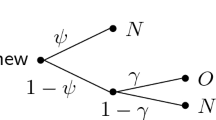The theory of signal detection is convenient for measuring mnemonic ability in recognition memory paradigms. In these paradigms, randomly selected participants are asked to study randomly selected items. In practice, researchers aggregate data across items or participants or both. The signal detection model is nonlinear; consequently, analysis with aggregated data is not consistent. In fact, mnemonic ability is underestimated, even in the large-sample limit. We present two hierarchical Bayesian models that simultaneously account for participant and item variability. We show how these models provide for accurate estimation of participants’ mnemonic ability as well as the memorability of items. The model is benchmarked with a simulation study and applied to a novel data set.
Similar content being viewed by others
References
Albert, J., & Chib, S. (1995). Bayesian residual analysis for binary response regression models. Biometrika, 82, 747–759.
Browne, W.J., & Draper, D. (2000). Implementation and performance issues in the Bayesian and likelihood fitting of multilevel models. Computer Statistics, 15, 391–420.
Clark, H.H. (1973). The language-as-fixed-effect fallacy: A critique of language statistics in psychological research. Journal of Verbal Learning and Verbal Behavior, 12, 335–359.
Devroye, L. (1986). Non-uniform random variate generation. New York: Springer-Verlag.
Gelfand, A., & Smith, A.F.M. (1990). Sampling based approaches to calculating marginal densities. Journal of the American Statistical Association, 85, 398–409.
Gelman, A., Carlin, J.B., Stern, H.S., & Rubin, D.B. (2004). Bayesian data analysis (2nd ed.). London: Chapman and Hall.
Gillund, G., & Shiffrin, R. (1984). A retrieval model for both recognition and recall. Psychological Review, 91, 97–123.
Glanzer, M., Adams, J.K., Iverson, G.J., & Kim, K. (1993). The regularities of recognition memory. Psychological Review, 100, 546–567.
Glanzer, M.A., Kim, K., Hilford, A., & Adams, J.K. (1999). Slope of the receiver-operating characteristic in recognition memory. Journal of Experimental Psychology: Learning, Memory, & Cognition, 25, 500–513.
Hautus, M.J., & Lee, A.L. (1998). The dispersions of estimates of sensitivity obtained from four psychophysical procedures: Implications for experimental design. Perception & Psychophysics, 60, 638–649.
Heathcote, A. (2003). Item recognition memory and the receiver-operating characteristic. Journal of Experimental Psychology: Learning, Memory, & Cognition, 29, 1210–1230.
Hobert, J.P., & Casella, G. (1996). The effect of improper priors on Gibbs sampling in hierarchical linear mixed models. Journal of the American Statistical Association, 91, 1461–1473.
Jacoby, L.L. (1991). A process dissociation framework: Separating automatic from intentional uses of memory. Journal of Memory and Language, 30, 513–541.
Jeffreys, H. (1982). Theory of probability. New York: Oxford University Press.
Kane, M.J., Hambrick, D.Z., Tuholski, S.W., Wilhelm, O., Payne, T.W., & Engle, R.E. (2004). The generality of working-memory capacity: A latent-variable approach to verbal and visuo-spatial memory span and reasoning. Journal of Experimental Psychology: General, 133, 189–217.
Kucera, H., & Francis, W.N. (1967). Computational analysis of present-day American English. Providence, RI: Brown University Press.
Lu, J., Speckman, P.L., Sun, D., & Rouder, J. (submitted). An objective Bayesian approach for assessing conscious and unconscious processes in human memory.
Macmillan, N.A., & Creelman, C.D. (2001). Detection theory: A user's guide. New York: Cambridge University Press.
McClelland, J.L., & Chappell, M. (1994). Familiarity breeds differentiation: A subjective-likelihood approach to the effects of experience in recognition memory. Psychological Review, 101, 103–128.
Miller, E., & Lewis, P. (1977). Recognition memory in elderly patients with depression and dementia: A signal detection analysis. Journal of Abnormal Psychology, 86, 84–86.
Ratcliff, R., Sheu, C.F., & Grondlund, S.D. (1992). Testing global memory models using ROC curves. Psychological Review, 99, 518–535.
Roberts, G.O., & Sahu, S.K. (1997). Updating schemes, correlation structure, blocking and parametrization for the Gibbs sampler. Journal of the Royal Statistical Society, Series B, Methodological, 59, 291–317.
Rouder, J.N., & Lu, J. (2005). An introduction to Bayesian hierarchical models with an application in the theory of signal detection. Psychonomic Bulletin and Review, 12, 573–604.
Rouder, J.N., Lu, J., Morey, R.D., Sun, D., & Speckman, P.L. (submitted). A hierarchical process dissociation model.
Salthouse, T.A. (1996). The processing speed theory of adult age differences in cognition. Psychological Review, 103, 403–428.
Shiffrin, R.M., & Steyvers, M. (1997). A model for recognition memory: REM—Retrieving effectively from memory. Psychonomic Bulletin and Review, 4, 145–166.
Singer, M., Gagnon, N., & Richard, E. (2002). Strategies of text retrieval: A criterion shift account. Canadian Journal of Experimental Psychology, 56, 41–57.
Snodgrass, J.G., & Corwin, J. (1988). Pragmatics of measuring recognition memory: Applications to dementia and amnesia. Journal of Experimental Psychology: General, 117, 34–50.
Spieler, D.H., & Balota, D.A. (1997). Bringing computational models of word naming down to the item level. Psychological Science, 8, 411–416.
Stretch, V., & Wixted, J.T. (1998). On the difference between strength-based and frequency-based mirror effects in recognition memory. Journal of Experimental Psychology: Learning, Memory, & Cognition, 24, 1379–1396.
Sun, D., & Berger, J. (1998). Reference priors under partial information. Biometrika, 85, 55–71.
Sun, D., & Berger, J.O. (2006). Objective priors for the multivariate normal model. Bayesian Statistics, 8.
Tanner, J.W.P., & Birdsall, T.G. (1958). Definition of d' and n as psychophysical measures. Journal of the Acoustical Society of America, 30, 922–928.
Tierney, L. (1994). Markov chains for exploring posterior distributions. Annals of Statistics, 22, 1701–1728.
Wickelgren, W.A. (1968). Unidimensional strength theory and component analysis of noise in absolute and comparative judgments. Journal of Mathematical Psychology, 5, 102–122.
Wishart, J. (1928). A generalized product moment distribution in samples from normal multivariate population. Biometrika, 20, 32–52.
Author information
Authors and Affiliations
Corresponding author
Additional information
This research is supported by NSF grants SES-0095919 and SES-0351523, NIH grant R01-MH071418, a University of Missouri Research Leave grant and fellowships from the Spanish Ministry of Education and the University of Leuven, Belgium.
Rights and permissions
About this article
Cite this article
Rouder, J.N., Lu, J., Sun, D. et al. Signal Detection Models with Random Participant and Item Effects. Psychometrika 72, 621–642 (2007). https://doi.org/10.1007/s11336-005-1350-6
Received:
Revised:
Published:
Issue Date:
DOI: https://doi.org/10.1007/s11336-005-1350-6




